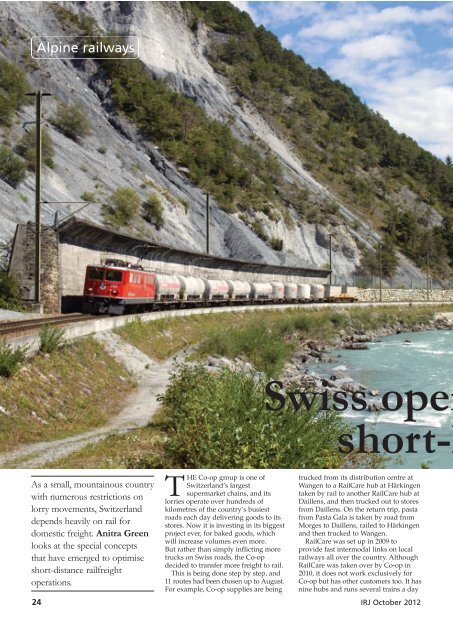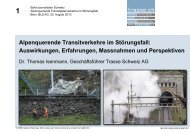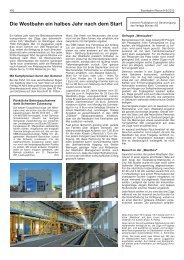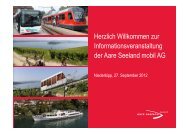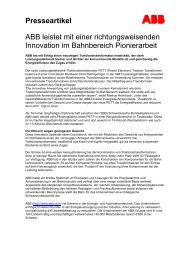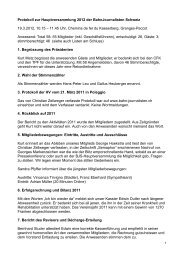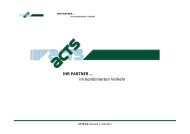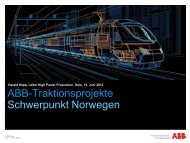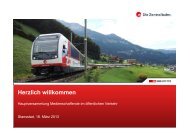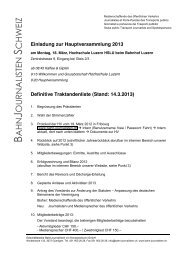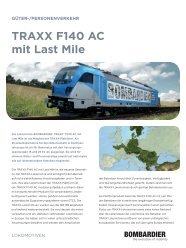Swiss oper short-h - bahn-journalisten.ch
Swiss oper short-h - bahn-journalisten.ch
Swiss oper short-h - bahn-journalisten.ch
- No tags were found...
You also want an ePaper? Increase the reach of your titles
YUMPU automatically turns print PDFs into web optimized ePapers that Google loves.
<strong>Swiss</strong> <strong>oper</strong><br />
<strong>short</strong>-h<br />
Alpine railways<br />
As a small, mountainous country<br />
with numerous restrictions on<br />
lorry movements, Switzerland<br />
depends heavily on rail for<br />
domestic freight. Anitra Green<br />
looks at the special concepts<br />
that have emerged to optimise<br />
<strong>short</strong>-distance railfreight<br />
<strong>oper</strong>ations.<br />
THE Co-op group is one of<br />
Switzerland’s largest<br />
supermarket <strong>ch</strong>ains, and its<br />
lorries <strong>oper</strong>ate over hundreds of<br />
kilometres of the country’s busiest<br />
roads ea<strong>ch</strong> day delivering goods to its<br />
stores. Now it is investing in its biggest<br />
project ever, for baked goods, whi<strong>ch</strong><br />
will increase volumes even more.<br />
But rather than simply inflicting more<br />
trucks on <strong>Swiss</strong> roads, the Co-op<br />
decided to transfer more freight to rail.<br />
This is being done step by step, and<br />
11 routes had been <strong>ch</strong>osen up to August.<br />
For example, Co-op supplies are being<br />
trucked from its distribution centre at<br />
Wangen to a RailCare hub at Härkingen<br />
taken by rail to another RailCare hub at<br />
Daillens, and then trucked out to stores<br />
from Daillens. On the return trip, pasta<br />
from Pasta Gala is taken by road from<br />
Morges to Daillens, railed to Härkingen<br />
and then trucked to Wangen.<br />
RailCare was set up in 2009 to<br />
provide fast intermodal links on local<br />
railways all over the country. Although<br />
RailCare was taken over by Co-op in<br />
2010, it does not work exclusively for<br />
Co-op but has other customers too. It has<br />
nine hubs and runs several trains a day<br />
24 IRJ October 2012
ators optimise<br />
aul railfreight<br />
covering about 200,000km a year, and<br />
completing a round trip within 24 hours.<br />
The philosophy is to keep the<br />
collection and delivery by road at either<br />
end of the rail trunk haul as <strong>short</strong> as<br />
possible. Trains run to fixed s<strong>ch</strong>edules<br />
at up to 120km/h, carrying up to 26<br />
containers ea<strong>ch</strong>. “This is not a lot, but<br />
we want to have <strong>short</strong>er trains for the<br />
sake of speed,” Mr Philipp Wegmüller,<br />
CEO of RailCare explains.<br />
Huge <strong>ch</strong>anges are in the pipeline,<br />
he says, with both new hubs and new<br />
services: “Our objective is only to have<br />
horizontal handling, including 40ft<br />
containers, and to automate all stages of<br />
handling as far as possible.” The latest<br />
innovation, introduced this year, was to<br />
equip the first of 60 refrigerated swapbodies<br />
with a GPS telematics system.<br />
One of RailCare’s clients is Heineken.<br />
The Heineken train, whi<strong>ch</strong> travels the<br />
length of the country between Domat<br />
and Daillens, uses an innovative new<br />
horizontal loading te<strong>ch</strong>nique dubbed<br />
ContainerMover 3000, designed by<br />
Innovatrain. “We wanted to develop a<br />
system that would cope with a standard<br />
20ft container as well as swap-bodies<br />
without any adaptation,” says Mr Pieter<br />
van den Bold, managing director of<br />
Innovatrain. The system comprises a<br />
“wagon adaptor” mounted on the lorry;<br />
it is hydraulically <strong>oper</strong>ated with<br />
electronic controls, and can transfer a<br />
unit weighing up to 22 tonnes between<br />
lorry and wagon within 3 minutes, even<br />
in extreme winter conditions. All it<br />
requires is a 3m wide stret<strong>ch</strong> of asphalt<br />
beside the railway.<br />
“We built the prototype in May 2011,<br />
and delivered the first 10 units to<br />
RailCare in November,” reports van den<br />
Bold. The system is attracting attention<br />
elsewhere too. “DB S<strong>ch</strong>enker selected<br />
two horizontal handling methods,<br />
including ours, and we demonstrated<br />
it to Volkswagen who were very<br />
impressed,” he says.<br />
“It’s very new; we’ve only had it on<br />
the market since the beginning of this<br />
year, and it’s important to prove it<br />
works well. But the first 10 units have<br />
already done eight months’ hard work<br />
for RailCare, so we’re making progress.”<br />
<strong>Swiss</strong> Federal Railways (SBB) set up<br />
its own subsidiary company called<br />
Cargo Domizil in 1981 specialising in<br />
intermodal overnight inland freight. It<br />
was taken over in 1996 by a consortium<br />
of three haulage companies - Planzer,<br />
Camion and Galliker - and, following<br />
restructuring and a new location<br />
concept, broke even for the first time<br />
two years later. Now it carries 10,000<br />
consignments a night between 10<br />
locations in Switzerland, with 60%<br />
by rail and 40% by road.<br />
Using Planzer’s logistics expertise,<br />
freight flows can be combined, transit<br />
times reduced, reliability improved,<br />
emissions cut, and full advantage taken<br />
of the <strong>Swiss</strong> ban on trucks driving at<br />
night. “Nobody at SBB Cargo has any<br />
logistics know-how,” explains<br />
Mr Fridolin Landolt, a Planzer board<br />
member. “But there is still room for<br />
improvement in the availability of rail<br />
infrastructure and locations for hubs,<br />
whi<strong>ch</strong> have to be in the right place.”<br />
From this year, Planzer is also<br />
masterminding the supply of goods to<br />
Zermatt, where road access is restricted.<br />
The Matterhorn-Gotthard Railway<br />
(MGB) was managing this <strong>oper</strong>ation<br />
itself, but realised it was more efficient<br />
to concentrate on running a railway and<br />
to commission an expert partner to look<br />
after the logistics side. Planzer formed a<br />
new company, Alpin Cargo, to deal<br />
with everything except carriage by rail<br />
under an initial five-year contract. “We<br />
have two terminals, one in Visp and one<br />
in Zermatt, and run 38 freight trains a<br />
week,” says Mr Jean-Pierre Wettstein,<br />
another Planzer board member. “From<br />
IRJ October 2012 25<br />
Photo: David Gubler
Alpine railways<br />
ContainerMover 3000 is a system for transferring containers between road and rail vehicles horizontally.<br />
Zermatt there’s another rail link to<br />
Gornergrat. We carry about 85,000<br />
tonnes of goods a year to Zermatt, and<br />
about a quarter is mineral oil. It’s<br />
proving to be a very successful concept.”<br />
At the eastern end of the country in<br />
Graubunden, the narrow-gauge<br />
Rhaetian Railway (RhB) is in a unique<br />
position. The whole of this canton is<br />
mountainous, and sometimes in winter<br />
the only access is by rail. RhB’s freight<br />
arm carries 750,000 tonnes per year<br />
using 460 wagons and serving 37<br />
freight yards. “One of our special<br />
features is that we <strong>oper</strong>ate mixed trains<br />
- a Co-op wagon coupled to a passenger<br />
train, for example,” says Mr Mattias<br />
Ts<strong>ch</strong>arner, head of freight at RhB.<br />
“Also we have a higher proportion of<br />
intermodal traffic than most. One of our<br />
customers, Aldi, always used road<br />
transport, but when they saw the<br />
mountains, they realised intermodal<br />
was the only way.” In this terrain,<br />
intermodal transport is economical over<br />
surprisingly <strong>short</strong> distances; the longest<br />
route, from Landquart to Samedan, is<br />
96km and the <strong>short</strong>est, from Arosa to<br />
Chur, a mere 26km. “This route is also<br />
the best earner,” smiles Ts<strong>ch</strong>arner.<br />
RhB’s intermodal success story<br />
started in 1992 with a working group<br />
studying the possibility of transporting<br />
foodstuffs in swap-bodies, and was<br />
quickly followed by trial runs. A big<br />
leap forward was a<strong>ch</strong>ieved in 1999 with<br />
the opening of a new handling centre in<br />
Landquart and the Vereina tunnel,<br />
leading to new services for both the<br />
Co-op and the Post Office. In 2000, RhB<br />
opened Europe’s highest intermodal<br />
terminal in Samedan at 1700m.<br />
RhB has increased the flexibility of<br />
its freight <strong>oper</strong>ations by running<br />
mixed trains. Photo: Robin Ralston<br />
On the import/export front, SBB<br />
Cargo is planning two major projects<br />
whi<strong>ch</strong> together will form the gateway<br />
to Switzerland for long-haul intermodal<br />
traffic from all over Europe. Planning<br />
permission for Gateway Limmattal,<br />
near Zuri<strong>ch</strong>, is being submitted this<br />
autumn. It will be built on the edge of<br />
an existing marshalling yard and will<br />
serve as the country’s main distribution<br />
centre from 2017. As Mr Daniel Bürgy,<br />
project leader for intermodal traffic at<br />
SBB Cargo, points out “2000 containers<br />
a day arrive in Switzerland from<br />
northern European ports, and this is<br />
expected to triple by 2030.”<br />
In parallel is the development of Basle<br />
Nord tri-modal terminal at Switzerland’s<br />
only port, whi<strong>ch</strong> will also be the<br />
gateway for northwest Switzerland.<br />
The work will be carried out in two<br />
stages, with road/rail facilities complete<br />
by 2015 and the tri-modal installations,<br />
including a new basin for barge traffic,<br />
opening three years later.<br />
There are still problems, however.<br />
One question raised time and again is<br />
the absolute priority given to passenger<br />
trains on Switzerland’s densely-used<br />
network. As Wettstein points out with<br />
regard to Alpin Cargo: “About 80% of<br />
Zermatt’s revenue comes from tourists,<br />
so priority for passenger trains is<br />
important. But we need another<br />
approa<strong>ch</strong>.” This view is expressed by<br />
many involved in the railfreight sector<br />
who resent having to delay a long-haul<br />
freight train for a frequent urban<br />
service. Another question is whether it<br />
makes sense to integrate domestic<br />
intermodal traffic with wagonload<br />
freight, as several experts have<br />
suggested. Only time will tell whether<br />
su<strong>ch</strong> views are realistic and translate<br />
into action in favour of railfreight. IRJ<br />
26 IRJ October 2012


